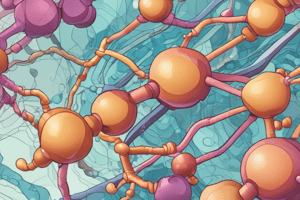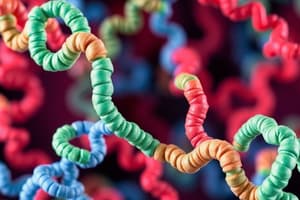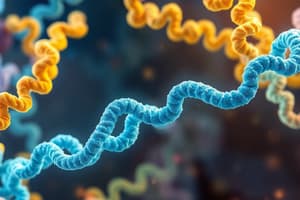Podcast
Questions and Answers
Which of the following characteristics distinguishes a biological protein from a polypeptide?
Which of the following characteristics distinguishes a biological protein from a polypeptide?
- Biological proteins are complexly folded, usually globular, while polypeptides are linear and smaller. (correct)
- Polypeptides are synthesized through a dehydration reaction, while biological proteins are synthesized through hydrolysis.
- Biological proteins are composed of fewer than 50 amino acids, while polypeptides contain hundreds or thousands.
- Polypeptides contain peptide bonds, while biological proteins contain only R-group interactions.
An amino acid's identity and chemical properties are determined by what?
An amino acid's identity and chemical properties are determined by what?
- The R side chain. (correct)
- The peptide bonds linking it to other amino acids.
- The amino and carboxyl terminal groups.
- The central carbon atom.
What type of reaction is involved in linking two amino acids together to form a dipeptide?
What type of reaction is involved in linking two amino acids together to form a dipeptide?
- Hydrolysis, which breaks the bond by adding water.
- Reduction, which involves the gain of electrons.
- Oxidation, which involves the transfer of electrons.
- Condensation, which removes water to form a peptide bond. (correct)
In a polypeptide chain, what chemical groups are found at the amino and carboxyl terminals, respectively?
In a polypeptide chain, what chemical groups are found at the amino and carboxyl terminals, respectively?
Given the prevalence of trans peptide bonds in biological proteins, what is the structural consequence?
Given the prevalence of trans peptide bonds in biological proteins, what is the structural consequence?
Which of the following best explains the role of the R-group in determining protein structure?
Which of the following best explains the role of the R-group in determining protein structure?
If a polypeptide consists of 45 amino acids, how would it be classified?
If a polypeptide consists of 45 amino acids, how would it be classified?
What is the primary difference between a dipeptide and a tripeptide?
What is the primary difference between a dipeptide and a tripeptide?
Which of the following best describes the role of fibronectin in the extracellular matrix?
Which of the following best describes the role of fibronectin in the extracellular matrix?
How do proteoglycans contribute to the function of the extracellular matrix?
How do proteoglycans contribute to the function of the extracellular matrix?
An athlete is aiming to increase muscle mass. If they weigh 80 kg, what would be an appropriate daily protein intake based on the guidelines provided?
An athlete is aiming to increase muscle mass. If they weigh 80 kg, what would be an appropriate daily protein intake based on the guidelines provided?
A person consumes a diet that provides 75 grams of protein daily. If they weigh 90 kg and lead a sedentary lifestyle, how does their protein intake compare to the recommended daily allowance?
A person consumes a diet that provides 75 grams of protein daily. If they weigh 90 kg and lead a sedentary lifestyle, how does their protein intake compare to the recommended daily allowance?
Why might a vegan diet require careful planning and supplementation compared to a diet that includes animal products?
Why might a vegan diet require careful planning and supplementation compared to a diet that includes animal products?
Which characteristic is common to polar neutral amino acids?
Which characteristic is common to polar neutral amino acids?
Why are certain amino acids classified as 'essential'?
Why are certain amino acids classified as 'essential'?
During the formation of a dipeptide, what type of reaction occurs and what molecule is released?
During the formation of a dipeptide, what type of reaction occurs and what molecule is released?
A polypeptide is being synthesized. What part of the incoming amino acid will react with the carboxyl terminus of the growing chain?
A polypeptide is being synthesized. What part of the incoming amino acid will react with the carboxyl terminus of the growing chain?
What structural characteristic is associated with α-helices?
What structural characteristic is associated with α-helices?
What is the role of a disulfide bond in protein structure?
What is the role of a disulfide bond in protein structure?
How does denaturation affect a protein's structure?
How does denaturation affect a protein's structure?
What is the primary function of hemoglobin?
What is the primary function of hemoglobin?
How does insulin regulate blood glucose levels?
How does insulin regulate blood glucose levels?
Which function is associated with collagen?
Which function is associated with collagen?
What is the approximate range of amino acid (aa) units typically found in a condensation?
What is the approximate range of amino acid (aa) units typically found in a condensation?
Which chemical bond is formed during the condensation of amino acids to create a polypeptide chain?
Which chemical bond is formed during the condensation of amino acids to create a polypeptide chain?
What chemical characteristics define the 'amino terminus' and 'carboxy terminus' of a polypeptide?
What chemical characteristics define the 'amino terminus' and 'carboxy terminus' of a polypeptide?
The 'R' group, or side chain, of an amino acid is responsible for what characteristic?
The 'R' group, or side chain, of an amino acid is responsible for what characteristic?
What is a zwitterion, and how does it relate to the structure of an amino acid?
What is a zwitterion, and how does it relate to the structure of an amino acid?
At a neutral cellular pH, how do the amino and carboxyl groups of an amino acid typically behave?
At a neutral cellular pH, how do the amino and carboxyl groups of an amino acid typically behave?
How does the polarity of an amino acid affect its interactions within a protein structure?
How does the polarity of an amino acid affect its interactions within a protein structure?
What chemical characteristic is commonly found in the side chains of non-polar amino acids?
What chemical characteristic is commonly found in the side chains of non-polar amino acids?
What are the three classifications of polar amino acids based on side chain properties?
What are the three classifications of polar amino acids based on side chain properties?
If an amino acid side chain contains a functional group that can readily donate a proton, how would it be classified?
If an amino acid side chain contains a functional group that can readily donate a proton, how would it be classified?
Flashcards
Amino Acid
Amino Acid
The basic unit (monomer) of proteins, consisting of an amine group, a carboxyl group, and a unique side chain (R).
Dipeptide
Dipeptide
A peptide formed by two amino acids linked by a peptide bond through a condensation reaction.
Polypeptide
Polypeptide
A linear chain of amino acids, usually consisting of 50 to 100 amino acids, that can fold into a protein.
R Group (Side Chain)
R Group (Side Chain)
Signup and view all the flashcards
Peptide Bond
Peptide Bond
Signup and view all the flashcards
Oligopeptide
Oligopeptide
Signup and view all the flashcards
Trans Form
Trans Form
Signup and view all the flashcards
Condensation Reaction
Condensation Reaction
Signup and view all the flashcards
Condensation
Condensation
Signup and view all the flashcards
Amino terminus
Amino terminus
Signup and view all the flashcards
Carboxy terminus
Carboxy terminus
Signup and view all the flashcards
Zwitterion
Zwitterion
Signup and view all the flashcards
R side chain
R side chain
Signup and view all the flashcards
Polar amino acids
Polar amino acids
Signup and view all the flashcards
Non-polar amino acids
Non-polar amino acids
Signup and view all the flashcards
Acidic amino acids
Acidic amino acids
Signup and view all the flashcards
Basic amino acids
Basic amino acids
Signup and view all the flashcards
Collagen
Collagen
Signup and view all the flashcards
Elastin
Elastin
Signup and view all the flashcards
Fibronectin
Fibronectin
Signup and view all the flashcards
Recommended Dietary Allowance (RDA) for Protein
Recommended Dietary Allowance (RDA) for Protein
Signup and view all the flashcards
Essential Amino Acids
Essential Amino Acids
Signup and view all the flashcards
Polar neutral amino acids
Polar neutral amino acids
Signup and view all the flashcards
Denaturation
Denaturation
Signup and view all the flashcards
Hemoglobin
Hemoglobin
Signup and view all the flashcards
Myoglobin
Myoglobin
Signup and view all the flashcards
Thyroid hormones (T3 and T4)
Thyroid hormones (T3 and T4)
Signup and view all the flashcards
Human Growth Hormone (hGH)
Human Growth Hormone (hGH)
Signup and view all the flashcards
Study Notes
Module 4: Proteins
- Proteins are biological molecules composed of amino acids (aa's).
- Proteins are essential to life and have diverse functions like structure and catalyzing reactions.
- Proteins contain the elements hydrogen, carbon, oxygen, nitrogen, and sulfur (sometimes).
Amino Acids and Protein Structure (Part A)
- Amino acids are the building blocks of proteins.
- There are 20 standard amino acids.
- Each amino acid has a central carbon atom bonded to an amino group, a carboxyl group, a hydrogen atom, and a variable side chain (R group).
- The R group determines the specific properties of each amino acid (polarity, acidity, and basicity).
- Some amino acids are essential, meaning they must be obtained through diet.
- Amino acids are linked together by peptide bonds through a dehydration reaction.
Protein Monomers: Amino Acids (aa's)
- Amino acids are the building blocks of proteins.
- 20 standard amino acids all with similar structure.
- Amino acids include an amine group (NH2) and carboxylic acid group (COOH).
- The side chain determines properties.
- Half of amino acids are 'essential' for humans, meaning we can't produce them.
Amino Acids are Joined by Peptide Bonds
- Amino acids join to form chains via peptide bonds.
- Peptide bonds form via condensation reaction; water is lost.
- Amino acids are linked end-to-end via peptide bonds, forming a polypeptide.
Peptide Bonds are Usually cis/trans
- In biological proteins peptide bonds are almost always in trans form.
- This is due to steric hindrance which makes cis configuration unfavorable.
Protein Peptides
- Protein dimers, trimers and oligomers are formed from amino acids linked together by peptide bonds.
- Peptides (like the polymers) do not branch; the linkages are linear.
- Peptides are formed by condensation reaction.
Protein Polymers: Biological Proteins
- Polypeptide chains of more than 50 aa's are considered proteins.
- Biological proteins typically contain hundreds of amino acids.
- Multiple proteins can be bonded together to form complex structures with folds or turns.
- Protein folding usually results in a compact, globular shape.
Amino Acid Functional Groups
- Amino acids have an amino terminus and a carboxyl terminus.
- The side chain (R group) determines an amino acid's properties (polarity).
Zwitterions
- Zwitterions are a form that amino acids can exist in, with both positive and negative charges.
- Amino acids are zwitterions at a neutral pH.
Amino Acid and Protein Polarity
- Polarity varies in amino acids, particularly along the side chains.
Amino Acids (by Classification)
- Amino acids are classified based on polarity and acidity/basicity of the side chain (R group).
Amino Acids (Non-polar)
- Nonpolar amino acids typically consist of carbon and hydrogen atoms.
- Nonpolar amino acids often have hydrophobic interactions.
Amino Acids (Polar, Neutral)
- Polar amino acids contain functional groups like hydroxyl (OH) or sulfide (SH).
Amino acids (Polar, Basic, or Acidic)
- Basic amino acids have positive charges at neutral pH.
- Acidic amino acids have negative charges at neutral pH.
Essential vs. Non-essential Amino Acids
- Eight essential amino acids for adults; 10 for children are required in daily diets.
- Nonessential amino acids can be produced in the human body.
Complete vs. Incomplete Protein Sources
- Complete proteins contain all essential amino acids.
- Animal proteins are typically complete.
- Plant proteins are usually incomplete.
Other Uses for aa's
- Some amino acids have functions beyond protein structure.
- For example, tryptophan synthesizes hormones as well as neurotransmitters.
Protein Synthesis: aa's → protein
- The process of protein synthesis involves linking amino acids together.
- The first level (1°) of protein structure is governed by DNA.
- Protein structure is determined by the sequence of amino acids.
Protein Structure
- Proteins have four levels of structure: primary, secondary, tertiary, and quaternary.
- Primary structure is the amino acid sequence.
- Secondary structure involves the folding of the polypeptide chain into a helix or sheet.
- Tertiary structure is the overall 3D shape of the protein.
- Quaternary structure is the arrangement of multiple interacting protein subunits.
1º Structure of Proteins
- Arrangement of amino acids in the polypeptide defines the protein's chemical structure.
- This structure is determined by DNA sequences (with the help of mRNA sequences).
2º Structure of Proteins (a-helix and b-pleated sheet)
- Hydrogen bonds between the backbone of the polypeptide chain stabilize the secondary structure.
- The secondary structures include alpha-helices (spiral) and beta-pleated sheets (folded).
2º Structure: The α-Helix
- A typical alpha-helix is ~10 amino acids long.
- The helix is right-handed and has 3.6 amino acids per turn.
- The peptide bond's C=O bonds hydrogen bond with the N-H of the fourth amino acid.
2º Structure: The β-Pleated Sheet
- Beta-pleated sheets can be parallel or antiparallel.
- Hydrogen bonds between adjacent chains contribute to the pleated sheet structure.
- The side chains of amino acids that form the pleated-sheet arrange alternately.
3º Structure of Proteins
- The 3D shape of the polypeptide chain arises from interactions between side chains (R groups).
- Interactions include disulfide bonds, hydrogen bonds, salt bridges, and hydrophobic interactions.
4 Main Forces holding 3º Protein Structure
- Disulfide bonds form between cysteine amino acids.
- Hydrogen bonds form between polar side chains.
- Salt bridges form between positively and negatively charged side chains.
- Hydrophobic interactions occur between nonpolar side chains.
4º Structure of Proteins
- This structures forms when multiple peptide chains join to form a functional protein.
- Often proteins combine with other protein subunits to form complex shapes.
- The forces that help to shape the protein are the same as those that contribute to 3º structure.
Antibody (Immunoglobulin) 4º structure
- Antibodies have a specific 4º structure, with disulfide bonds.
- Antibodies have specific components or regions, such as the antigen-binding region and constant region.
- Antibodies play a key role in the immune system by binding to and neutralizing pathogens.
4º Protein Example -- NAD(P)H oxidase
- This enzyme's subunits associate and dissociate in coordination with activation.
Protein Denaturation
- Denaturation disrupts the 2º, 3º, and 4º protein structure; the 1º structure remains.
- Denaturation can occur through physical methods such as heat, or through the chemical interaction with other agents like acids or bases.
Denatured Protein: Fried Egg
- Albumin is the protein found in eggs.
- Heat denatures albumin, making the egg white opaque and hard.
Static and Dynamic Proteins (Part B)
- Dynamic proteins are not fixed in one location.
- Static proteins are fixed at a specific location in the body.
Serum Albumins (dynamic)
- They maintain osmotic pressure, transport non-polar molecules.
Globulins (dynamic)
- They're involved in transporting various molecules within the blood, and binding/eliminating foreign molecules (ie antibodies)
Hemoglobin
- Located in red blood cells.
- Contains heme prosthetic group, which is involved with oxygen transport.
- It comprises of 4 subunit polypeptide chains held together by weak interactions.
Myoglobin
- Located in muscle cells.
- Binds to oxygen and stores it for muscle function.
- A monomer, and not a part of blood plasma.
Dietary Protein
- 50% of our body mass comes from protein.
- Dietary intake is vital for the construction of body mass.
- Complete proteins are ideal.
Protein Sources
- Different foods contain differing quantities of protein.
- Meat, poultry, dairy, eggs, and legumes are good protein sources.
- Vegetable sources are also essential.
Protein Intake Recommendations
- Protein needs vary by age, activity level, and other factors.
- Most adults need ~ 10-35%.
‘New’ Canada Food Guide (2019)
- Provides guidance on protein intake, as part of a balanced diet.
How Much Protein Do We Really Need?
- The recommended daily allowance for protein intake is based on body mass and activity.
Collagen (static)
- Collagen is the most abundant protein in mammals and plays a key role in tissue structure.
- Cross-linked and stabilized by hydrogen bonds.
- Important component of skin and connective tissues.
Elastin (static)
- Elastin provides elasticity to tissues like skin, lungs, and arteries.
- Cross-linked via disulfide bonds between cysteine amino acids.
- Its loss with aging leads to tissue sagging.
Proteoglycans (static)
- These proteins are found in connective tissues and provide hydration and support.
- They consist of a core protein with multiple side chains.
Fibronectin (static)
- Fibronectin acts as a connecting protein in connective tissues, including joints, skin and various other tissues.
- Important in processes requiring cell adhesion.
Actin and Myosin (static/dynamic) (both)
- Myosin and Actin are major components of muscle cells.
- Important in muscle contractions.
Protein in Different Cell Environments (example)
- Proteins act in a variety of functions within and outside cells, affecting important processes.
Studying That Suits You
Use AI to generate personalized quizzes and flashcards to suit your learning preferences.




